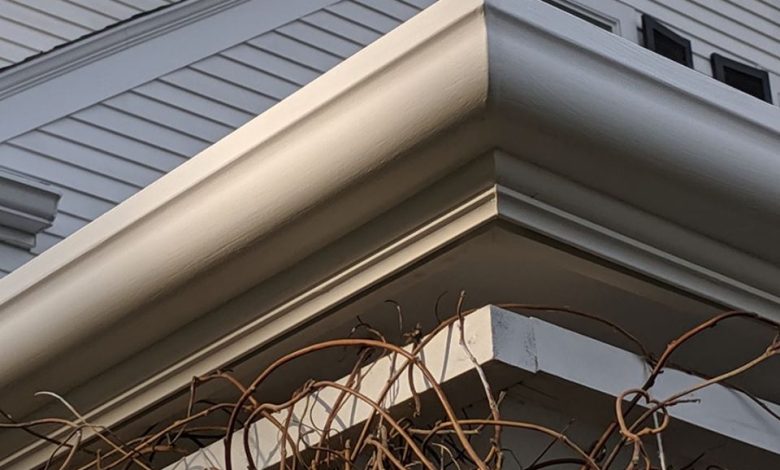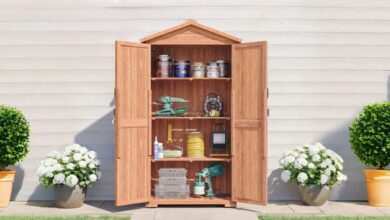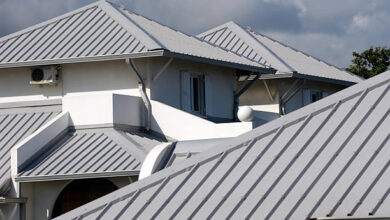Eavestrough Repair: An Essential Component of Your Home’s Roofing System

Your home’s roofing system comprises several important components, including the shingles, underlayment, flashing, and eavestroughs. While the first three components protect your roof from water damage, the eavestroughs are crucial in directing rainwater away from your home’s foundation. In this article, we’ll take a closer look at eavestroughs and why they’re essential to maintaining the integrity of your home.
What is an Eavestrough?
An eavestrough, also known as a rain gutter or gutter, is a trough that is installed along the edge of your roofline. Its function is to collect rainwater and divert it away from the foundation of your house to avoid erosion and water damage. Eavestroughs are typically made of metal, such as aluminum, steel, or copper, although vinyl and other materials are also available.
The Benefits of Eavestroughs
Eavestroughs offer several benefits to homeowners, including:
- Preventing Water Damage: Eavestroughs are primarily used to divert rainwater away from your home’s foundation. Without eavestroughs, rainwater can collect around your foundation and seep into your basement or crawl space, causing water damage and potentially leading to mold growth.
- Protecting Your Home’s Exterior: Rainwater can also damage your home’s exterior, including the siding, windows, and doors. By directing rainwater away from your home, eavestroughs can help prevent costly repairs.
- Maintaining Your Home’s Structural Integrity: Water damage can weaken your home’s foundation, causing cracks, settling, and other structural issues. Eavestroughs help maintain your home’s structural integrity by preventing water damage.
- Enhancing Your Home’s Aesthetics: Eavestroughs can be customized to match your home’s exterior, adding to its curb appeal and overall aesthetics.
Installation and Maintenance of Eavestrough
Eavestroughs, also known as gutters, is a critical component of your home’s roofing system, responsible for directing rainwater away from your foundation and preventing water damage. Eavestroughs installed and maintained correctly may safeguard your house and reduce the need for expensive repairs. We’ll take a deeper look at eavestrough installation and upkeep.
Read More: What Are HVAC System Parts? A Comprehensive Overview Of Objectives Of HVAC Systems
Installation of Eavestrough
Proper installation of eavestroughs is essential to their effectiveness. Here are some key steps to installing eavestroughs correctly:
- Choose the right material: Copper, steel, and aluminum are just a few materials that may be used to make eavestroughs. While selecting the material, consider your budget, climate, and aesthetic preferences.
- Measure and plan: Measure the length of your roofline and plan the placement of downspouts. Ensure downspouts are placed at least five feet from your home’s foundation.
- Install hangers and brackets: Install hangers and brackets to support the eavestroughs regularly. Ensure that the hangers and brackets are securely fastened to the roofline and can support the weight of the eavestroughs when full of water.
- Install downspouts and extensions: Install downspouts and extensions to direct rainwater away from your home’s foundation. Ensure that downspouts are securely fastened to the eavestroughs and extensions are sloped away from your home.
Maintenance of Eavestrough
Proper maintenance of eavestroughs is crucial to their effectiveness and longevity. Here are some tips for maintaining eavestroughs:
- Maintain cleanliness: Eavestroughs should be cleaned at least twice a year, ideally in the spring and fall. Remove any leaves, twigs, or other debris that could clog the eavestroughs and stop rainwater from flowing through them.
- Check for damage: Check eavestroughs, including cracks, holes, and rust. Repair or replace damaged sections promptly to prevent water damage.
- Check for proper slope: Ensure that eavestroughs are sloped correctly, with a downward slope toward downspouts. If eavestroughs are not sloped correctly, water can pool and cause damage.
- Trim trees: Trim tree branches that hang over eavestroughs to prevent leaves and other debris from falling into them.
Proper installation and maintenance of eavestroughs are crucial to protecting your home from water damage. When installing eavestroughs, ensure you choose the right material, measure and plan correctly, and install hangers and brackets securely. When maintaining eavestroughs, clean regularly, check for damage, ensure proper slope, and trim trees. Contact a qualified roofing contractor if you want assistance with eavestrough installation, maintenance, or repair.
Repairing Common Problems with Your Eaves to Preserve Your House
Gutters, also known as eavestroughs, are essential for preventing water damage to your property. Unfortunately, they are susceptible to damage or obstruction over time, resulting in problems that reduce efficiency. In this article, we’ll look closer at eavestrough repair and some common issues homeowners may encounter.
Why Eavestrough Repair is Important
Rainwater should be diverted away from your property’s foundation using eavestroughs to avoid water damage. When eavestroughs become damaged or clogged, rainwater can collect around your foundation and seep into your basement or crawl space, causing costly water damage and potentially leading to mold growth. Repairing eavestroughs promptly can help prevent these issues and protect your home.
Common Eavestrough Issues
Here are some of the most common eavestrough issues that homeowners may encounter:
- Clogs: Rainwater cannot flow through eavestroughs blocked with leaves, twigs, and other debris. This can cause water to overflow and pool around your foundation, leading to water damage. Regular cleaning can help prevent clogs.
- Leaks: Eavestroughs can develop leaks due to corrosion, damage from fallen branches, or improper installation. Leaks may cause expensive damage by allowing water to leak into your house’s interior or external walls.
- Sagging: Eavestroughs that are improperly installed or not adequately supported can begin to sag or pull away from your home. This can cause water to pool in the sagging area, damaging water and potentially compromising the eavestrough’s effectiveness.
Eavestrough Repair Solutions
Here are some solutions to common eavestrough issues:
- Keeping your eavestroughs clean regularly will assist in avoiding blockages and maintaining proper operation. If cleaning your eavestroughs yourself makes you uneasy, contact a pro.
- Sealing Leaks: Small leaks can often be sealed with caulk or sealant. However, larger leaks may require patching with metal flashing or replacing an eavestrough section.
- Reinforcement: Sagging eavestroughs can be reinforced with additional hangers or brackets to prevent further damage and ensure proper water flow.
What are eavestroughs and downspouts?
Eavestroughs and downspouts are an essential part of a home’s roofing system. They are made to collect and reroute rainwater, melting snow away from your home’s foundation, and capture and divert melting snow.
Eavestroughs, or gutters, are channels installed along the roof’s edge to collect and redirect water. They are typically made of metal, such as aluminum or steel, but other copper and vinyl materials are also available. Eavestroughs are available in different sizes and shapes to accommodate different types of roofs. They are usually installed with a slight slope to ensure water flows toward the downspouts.
Connected to the bottom of the eavestroughs, downspouts, leaders, or drainpipes move water away from the house’s foundation. They may be found in various sizes and designs and are normally constructed from the same materials as eavestroughs. Downspouts can be rectangular or round and installed on the outside or inside of the home.
Why are Eavestroughs and Downspouts Important?
Eavestroughs and downspouts are critical in protecting your home from water damage. When it rains or snows, water runs off the roof and into the eavestroughs, which direct the water to the downspouts. The downspouts then carry the water away from the home’s foundation, preventing water from seeping into the basement or causing erosion around the foundation.
Types of Eavestroughs and Downspouts
Depending on your tastes and financial capabilities, there are several varieties of eavestroughs and downspouts to pick from.
- Aluminum Eavestroughs and Downspouts Aluminum is the most popular material for eavestroughs and downspouts because it is durable, lightweight, and rust-resistant. Aluminum is also easy to install and comes in various colors to match your home’s exterior.
- Copper Eavestroughs and Downspouts Copper eavestroughs and downspouts are more expensive than aluminum but more durable and long-lasting. Copper is a beautiful material that ages gracefully and adds a touch of elegance to any home.
- Vinyl Eavestroughs and Downspouts Vinyl eavestroughs and downspouts are the least expensive option and are easy to install. However, they are not as durable as aluminum or copper and may crack or warp.
- Steel Eavestroughs and Downspouts Steel eavestroughs and downspouts are strong and durable but prone to rusting and require regular maintenance to prevent corrosion.
Maintenance of Eavestroughs and Downspouts
Maintaining eavestroughs and downspouts is essential to ensure they function properly and last as long as possible. Here are some tips for maintaining your eavestroughs and downspouts:
- Clean your eavestroughs and downspouts regularly to remove leaves, twigs, and other debris that can clog them and prevent water from flowing properly.
- Repair any leaks, holes, or cracks in your eavestroughs and downspouts as soon as possible to prevent water damage to your home.
When to Call a Professional
While some eavestrough issues can be addressed with DIY solutions, more extensive damage or complex repairs may require the assistance of a professional roofing contractor. If you’re unsure whether your eavestroughs require repair or replacement, contact a professional to assess the situation and recommend the best course of action.
Rainwater should be diverted away from your property’s foundation using eavestroughs to avoid water damage. Repairing common eavestrough issues, such as clogs, leaks, and sagging, is crucial to maintaining their effectiveness and protecting your home. If you require eavestrough repair, consider contacting a professional roofing contractor to assess the situation and recommend the best solution.
Conclusion
Eavestroughs are an essential part of its roofing system to prevent water damage to your home’s foundation, exterior, and structural integrity. A professional roofing contractor should be contacted if you need eavestrough installation or maintenance to guarantee the job is done correctly. Eavestroughs are an investment that can safeguard your property and keep it in peak shape for many years.
FAQs
Apart from this, if you are interested to know more about Stone-Coated Metal Roofing then visit our HOME IMPROVEMENT category.



